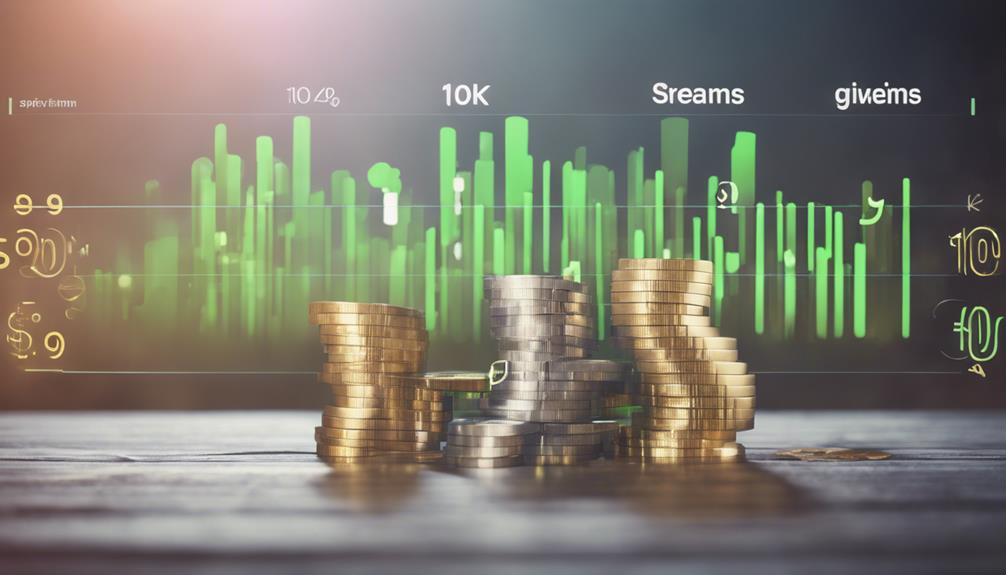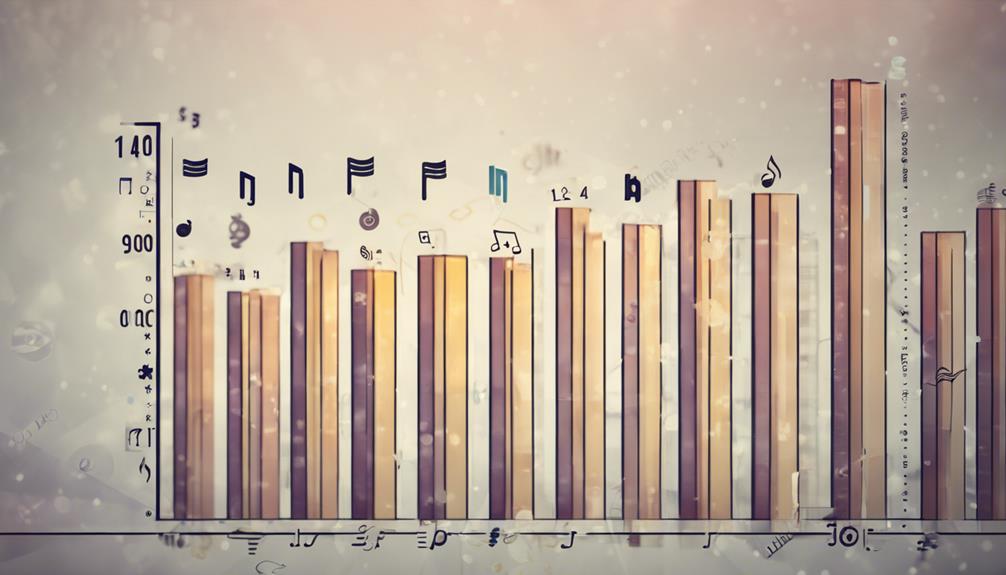
How much do you get paid for 10k streams on Spotify?
On Spotify, you can expect to earn about $40 for 10k streams, given the platform’s average per-stream payout of roughly $0.004. However, your actual earnings can vary due to factors such as stream demographics and your unique royalty agreements. Spotify’s payout model involves quite a few variables, and the distinction between premium and free streams can influence your earnings too. Understanding how the whole system works, including the impact of streaming quality and tactics to increase your Spotify earnings, can put you on a path to maximize your income from streaming. Push on for more insights into optimizing Spotify revenues.
Key Takeaways
- Spotify pays approximately $0.004 per stream, making earnings from 10K streams around $40.
- Payouts can vary based on factors like stream demographics and royalty negotiations.
- Major record labels may negotiate higher payouts for their artists.
- Spotify Premium streams earn more than Free streams due to higher royalties.
- Increasing earnings can be achieved with strategies like audience targeting and effective album promotions.
Understanding Spotify’s Payment Model

Before diving into how much you’ll earn from 10K streams on Spotify, you need to grasp their unique payment model. It’s not as simple as more streams equal more money. Instead, Spotify’s pay-per-stream rate varies, influenced by several factors.
Spotify’s partnerships play a significant role in their payment model. Partnering with record labels, distribution companies, and rights organizations allows Spotify to legally stream music, but these partnerships also mean that part of your earnings go to these entities. It’s a key element of the equation that affects your final payout.
Revenue diversification is another aspect of Spotify’s model. Ad revenues, subscriptions fees, and even user locations impact how much you make from streams. For instance, streams from paying subscribers usually generate more revenue than those from users on the free version. Similarly, streams from countries with higher subscription rates often yield higher earnings.
In order to truly maximize your earnings from Spotify streams, you’ll need to understand and navigate this complex model. It’s not just about the number of streams, but about leveraging Spotify’s partnerships and diversifying your revenue sources.
But don’t worry, we’ll get into the nitty-gritty of calculating those earnings in the next section.
Calculating Earnings From 10K Streams
Now, let’s explore how to calculate your potential earnings from 10K streams on Spotify. First, understand that Spotify doesn’t pay a fixed rate per stream. They use a complex formula factoring in stream demographics and royalty negotiations.
Spotify’s payment model generally offers between $0.003 and $0.005 per stream. Let’s take the average, $0.004, for our calculation. Multiply your total streams, in this case 10,000, by the per-stream payout. The math looks like this: 10K streams * $0.004/stream = $40.
So, on average, you’d earn around $40 for 10K streams. However, that’s a simplified calculation. You must also consider your stream demographics. If your listeners are primarily from high-value markets like the U.S. or U.K., you might earn more.
Royalty negotiations also impact your earnings. If you’re an independent artist, you’ll likely get the standard rate. But big labels often negotiate higher rates, so their artists earn more per stream.
Lastly, remember that Spotify distributes about 70% of its revenue to rights holders. So, your earnings also depend on Spotify’s total revenue and the total number of streams on the platform.
Factors Influencing Spotify Payouts

Understanding the intricacies of Spotify’s payout structure isn’t as fundamentally straightforward as it seems, given the multitude of factors at play that determine how much you make from your streams. Royalty determination is one of these crucial factors. In essence, this is a process where Spotify calculates the royalties owed to rights holders based on their proportion of total streams. It’s a complex system that often results in varying payouts for different artists.
Contractual agreements also heavily influence your earnings. These are agreements you have with record labels, distributors, or other intermediaries. Depending on your contract’s terms, a significant portion of your Spotify earnings may go to these entities before reaching you. It’s not uncommon for artists to receive only a fraction of the total payout after all contractual obligations are met.
Furthermore, your listener’s location can affect your payout. Spotify has different rates for different regions, meaning a stream from the U.S. might pay more than one from a less economically developed country. Understanding these variables can help you better navigate the Spotify payout system and potentially maximize your earnings.
Role of Streaming Quality in Earnings
When it comes to earnings, the quality of your streams also plays a significant role. This Stream Quality Impact can lead to Earnings Variation, so don’t overlook it.
- Bitrate: Higher bitrates mean better quality, and better quality can lead to more listener engagement. If your songs are streamed in high definition, it could potentially lead to more streams, and ultimately, higher earnings.
- Buffering: Frequent buffering can disrupt the listening experience, potentially causing listeners to skip your song. This skip-rate impacts your earnings, as Spotify only counts a stream if the listener plays at least 30 seconds of a track.
- Audio Quality: High audio quality can enhance the listener’s experience, encouraging them to listen to more of your music. This increased engagement can lead to more streams and higher earnings.
Understanding these factors and optimizing your music for the best streaming quality can help maximize your earnings.
Keep in mind, though, that quality isn’t the only factor. Other aspects, including the listeners’ location, the number of active monthly listeners, and the total number of streams, also influence your earnings.
The Impact of Spotify Premium Subscriptions

In the world of Spotify streaming, Premium subscriptions greatly influence your potential earnings. With Premium, listeners enjoy an ad-free experience that gives them unlimited skips and offline listening – benefits that go beyond the basic subscription. But how do these Premium features impact your earnings as an artist?
The answer lies in Spotify’s payout formula. Spotify calculates royalties based on the total number of streams that your music receives relative to the total streams on the platform.
But it’s not just a simple numbers game. Premium streams are actually worth more than Free streams. Why? Because Spotify’s revenue comes from two sources: ad-supported Free tier and Premium subscriptions. With Premium subscriptions costing more than the ad-supported tier, Premium streams generate higher revenue, hence, higher royalties.
Comparing Spotify Earnings to Other Platforms
Comparing your potential earnings on Spotify to other platforms can shed light on the financial viability of your music career. Platform diversity is essential, and understanding revenue comparison can guide you in building a sustainable income stream.
Apple Music: Apple tends to pay more per stream than Spotify, about $0.0056 per play. Your 10K streams could potentially earn around $56, compared to Spotify’s averae of $40.
Tidal: Tidal pays even more per stream, roughly $0.0125. Those 10K streams on Tidal could net you $125, demonstrating the importance of platform diversity.
YouTube: In contrast, YouTube’s pay per stream is significantly less, coming in at about $0.00074. So, your 10K streams there would only generate around $7.40.
From these comparisons, it’s clear each platform has its own rate, and diversifying your music distribution can have a substantial impact on your earnings.
While Spotify may not offer the highest pay per stream, they’ve a vast user base which can lead to high play counts. It’s a balancing act, considering both the payment rate and potential audience reach. By strategically spreading your music across platforms, you can maximize your potential revenue.
Ways to Increase Your Spotify Earnings

Boosting your earnings on Spotify isn’t just about producing great music; it’s also about strategic marketing. Optimizing playlist placements can notably increase your exposure, while effective album promotions can draw in more listeners.
Let’s explore these methods and learn how you can apply them to maximize your Spotify earnings.
Optimizing Playlist Placements
Securing a prime spot on popular playlists can greatly increase your Spotify earnings, with every 10K streams translating into real cash. To optimize your playlist placements, focus on playlist aesthetics and audience targeting.
- Playlist Aesthetics: Enhance the visual appeal of your playlists. Use compelling cover art and engaging titles that resonate with your music style. A beautifully curated playlist attracts more listeners, driving your streams upwards.
- Audience Targeting: Understand your listeners. What’s their demographic? What other music do they like? Tailor your playlist to meet their tastes. Targeting an audience that’s likely to enjoy your music increases the chance of them listening to your tracks repeatedly.
- Network and Collaborate: Build relationships with other musicians and playlist curators. Collaborate with them to cross-promote your music. This could lead to your songs being added to their popular playlists, giving your tracks more exposure.
Effective Album Promotions
To further boost your earnings on Spotify, it’s crucial to effectively promote your album, as this not only increases your visibility but also attracts more listeners who might become loyal fans.
One innovative strategy to explore is social media marketing. Platforms such as Instagram, Facebook, and Twitter provide an avenue to reach a wider audience. You can create engaging posts about your music, utilize hashtags related to your genre, and interact directly with your fans.
Promotional collaborations also offer a promising approach. Consider partnering with other artists or influencers to cross-promote each other’s work. This isn’t only a cost-effective strategy but also exposes your music to a new audience, potentially increasing your streams.

